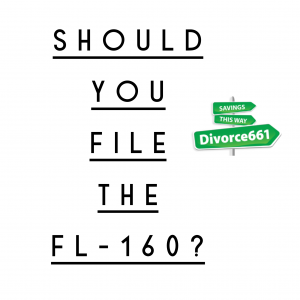Do I Need To File The FL-160 With FL-100 For California Divorce?
In this video we’re talking a little bit about procedure and when you file your paperwork with the court. So most people come to us before they’ve ever started the process, but we do get a lot of folks who come to us some point in the middle of their divorce process.
Maybe they filed, they served, they did some disclosures, and then they get hung up at some point, they’ll call us for help, and we’ll pick up where they left off. And that’s no problem. We do that all the time. But we see a lot, when people do start their own divorce, is they will file what’s called their property disclosures or declarations.
I’m referring to the FL 160s. And we tell folks, when you’re filing for divorce, when you’re going through this process, I know you don’t understand the process, someone’s telling you how to do this, or you read something online, or maybe you went to a clinic of sorts and they’ll tell you to fill out the FL 160s. We’re telling our clients, if you’re watching this and you’re not our client obviously, not to use the FL 160s when filing your petition for divorce.
You can always do your property declarations later. The issue becomes when you attach your FL 160, your list of assets and debts, to your petition, you file that, you serve it, and then you get to the judgment phase. If you come to an agreement other than what you disclosed or how you drafted your property declarations, the FL 160s, you have to dispose of all those assets and debts likely exactly as you proposed on your petition.
So if you are going to come to an agreement with your spouse, there’s no need to attach the disclosures or the declarations rather to your FL 160 because it allows you when you come to an agreement with your spouse, you get to make those decisions as you see fit. So for an example, with our clients, when we start, file a petition where it says to list the separate and community property we don’t list any assets and debts.
We simply say something like, to be amended or to be determined at a later time. We’re not listing any assets and debts there and we’re definitely not attaching the FL 160s. If your case becomes, is a default case, you can always amend the petition and then attach your FL 160s. That’s the better way to go, so for our clients, we don’t list any assets or debts on the petition itself.
All of the agreements, the division of assets and debts will come on the actual settlement agreement and that will supersede anything that has been put in the petition itself. So you don’t have to worry about listing your property on the petition when you file for a divorce in California.
Tim Blankenship, divorce661.com. Hope you’re having a great day. Thanks so much for watching. Take care.


